How to sell paintings online and make money

If you want to sell paintings online but don’t know where to start, then you’re in the right place.
Whether you’re an experienced artist or just getting started, this guide will teach you the key steps about how to sell paintings online. From deciding what to sell to setting up your painting website and promoting your artwork in the most effective ways, we’ve got you covered.
With online art sales reaching $11.8 billion, it’s now easier than ever for independent artists to reach collectors worldwide and make money with your creative passion. Let’s get started.
How to sell paintings online
Selling your paintings online doesn’t have to be complicated. In fact, it can be pretty simple if you follow these steps.
1. Decide what to sell
Before you start selling paintings, you need to decide what kind of paintings you will sell.
If you’re an artist who uses classic mediums and sees your art as one-of-a-kind, you can sell originals. This typically offers the highest value and comes with higher prices.
On the other hand, you can sell prints of original artwork made using various high-quality printing techniques such as giclee and lithograph. This lowers the costs, and you can sell multiple prints of the same original artwork.
Many artists decide to sell a combination of both while also being available for custom work.
Lolo and Co Art is a great example of this. They create hand-painted acrylic artwork inspired by nature and sell the originals, paper, and canvas prints. They are also available for commissioned work.
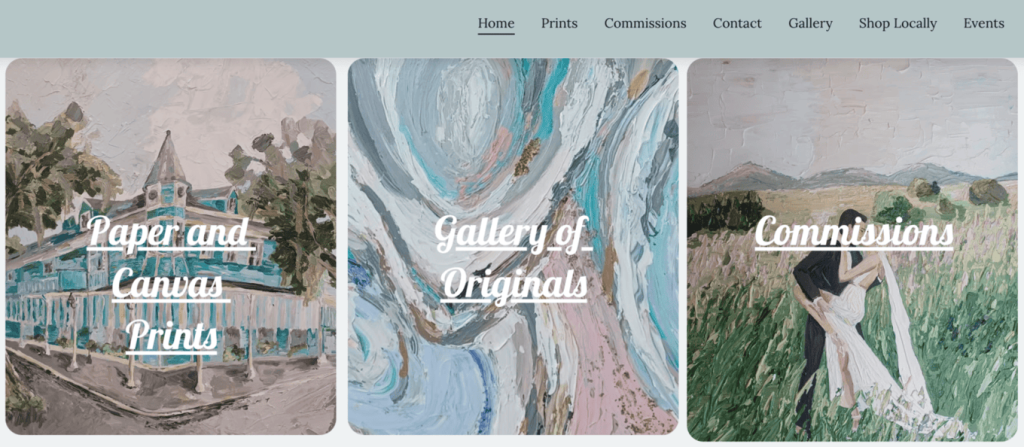
Another approach is to only do commissions, like Mo Bailey Art, who specializes in pet portraits. People who want portraits of their pets are looking for custom art, so it makes sense to only focus on commissions.

2. Create your painting website
One of the best ways to start a painting business online is with your own artist website.
This is where you can showcase your work in the best way possible without any limitations. You can also customize your website to reflect your painting style and your personality.
Like the example websites in this guide, we’ll use Hostinger Website Builder to show you how to create a painting website. It has many AI tools to help you get set up quickly, is easy to use, and offers exceptional value for money.
Store design
When building your website with Hostinger Website Builder, ensure there is ample whitespace to highlight your art.
You can choose from a range of Hostinger Website Builder themes designed for artists. Themes are like templates, where you can add your own images and content as well as tweak the layout and colors to suit your style.
That’s what Vonderhaart did with their website, where they sell prints of repurposed artwork. They used the Elisha theme as a starting point and personalized it to their liking.
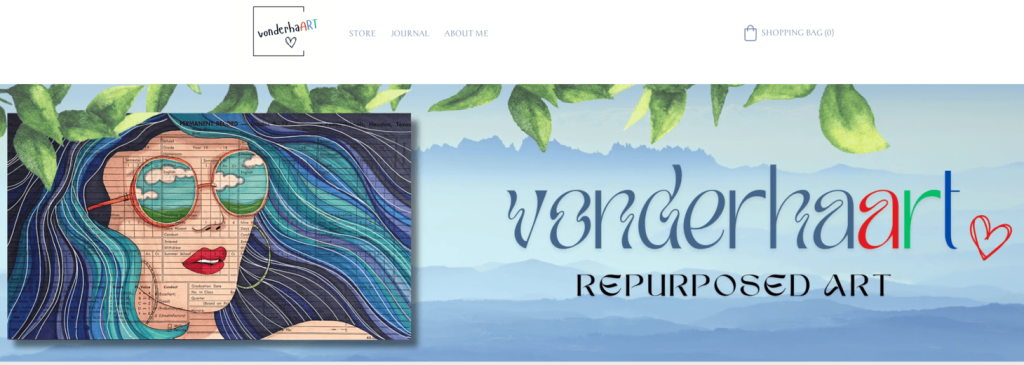
Important pages
Think of your website as an art portfolio website where you can showcase your work and tell your unique story. To do this, you need certain pages where customers can see your work and learn more about you, such as a homepage, about page, product pages, and a contact page.
A gallery page where you highlight your work can also be incredibly helpful. This is your opportunity to let your work shine, so don’t be shy about it.
Gabrielle Carre Art does an amazing job of showcasing its artwork and telling the story behind the paintings. Their gallery page includes the inspiration for each painting, giving visitors a unique glimpse into the artist’s thought process.
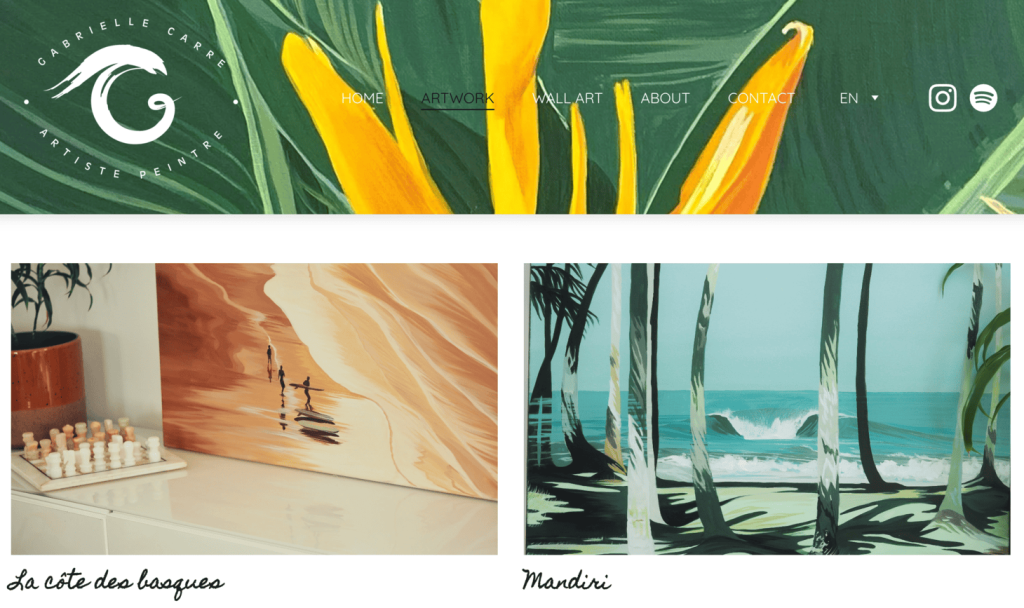
3. Explore online marketplaces
Other than your own website, it’s a good idea to explore online marketplaces, where people are already shopping for different types of artwork.
These marketplaces are a great place to gain more exposure for your paintings and build your brand.
The downside is that there is a lot of competition, so you need to connect with the right audience who loves your specific style.
Here are some of the top marketplaces to start with:
General marketplaces
Etsy and eBay are two great options to check out. Etsy is a popular marketplace for handmade arts and crafts, while eBay allows users to buy and sell various products, including artwork.
Both have massive audiences for you to tap into. Etsy counts over 96 million active buyers worldwide across their network, while eBay has over 132 million active buyers worldwide.
These platforms are also designed to be user-friendly, so you can easily set up and manage your listings.
The biggest downside, just like with most online marketplaces, is you’ve got fees to deal with. Etsy charges a listing fee of $0.20 per item and a 5% transaction fee on sales, whereas eBay allows up to 250 free listings per month. They do charge $0.40 for items over $10 and up to 15% of the total amount of a sale. These costs can quickly add up and cut into your profits.
You also compete with 9 million active sellers on Etsy, and 2.1 billion listings on eBay, which makes standing out a challenge.
Art-specific marketplaces
Listing your paintings on art-specific marketplaces, like Saatchi Art, Artfinder, Society6, and Fine Art America, is a great way to get your artwork in front of art lovers.
These marketplaces allow you to reach a worldwide audience of people who are looking specifically for art. This gives you a more targeted audience compared to general online marketplaces and a wider audience compared to local galleries.
Compared to physical art galleries, these marketplaces charge lower commissions, typically between 10% and 40%, depending on the site. But you’re still paying a fee to sell your artwork, compared to selling it on your website, where you don’t have to pay anyone else a commission.
The other drawback of these art-specific marketplaces is that due to their popularity, there are so many other artists competing for attention. This means that to stand out in the crowded marketplace, you might have to sell your work for less than you would in person or on your website.
The best approach
There are so many options available to you. The best approach might be to pick one or two online marketplaces to focus on at first while also showcasing your work on your website.
These online marketplaces have thousands of visitors looking to buy great artwork. But simply listing your paintings there doesn’t guarantee sales, and as you’ve seen, the fees you pay often cut into your profits. You still need to build your brand through marketing and your website.
Sam Edwards Artist has the right approach. While he sells prints of cities and townscapes on Etsy, he also sells originals of those prints on his website. This way, he uses the marketplaces to gain exposure for his artwork while sending buyers to his website for his higher-value work.
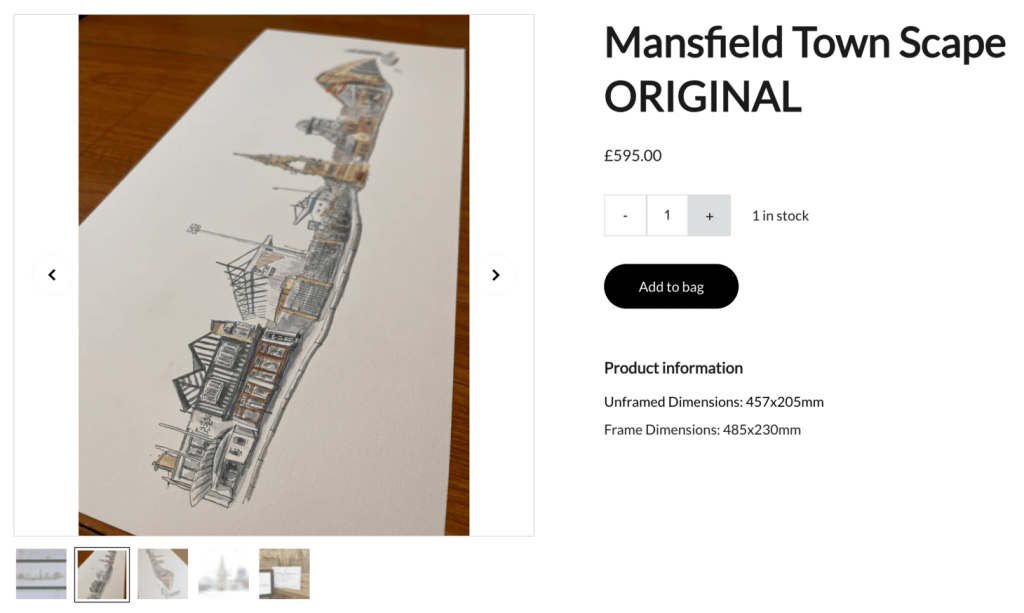
4. Price your paintings competitively
Pricing your artwork can be tricky. You have to consider not only your costs but also your experience, your creativity, and your time.
Your costs
The first factor you need to consider is the material costs associated with your work.
What materials did you use? How much did they cost? What other expenses did a particular artwork incur?
Your value
Once you have an idea of these concrete costs, you then have to add in items like the time you spent creating the art. Most beginner artists tend to undervalue their time and work.
The problem is that factors like time, experience, and creativity have subjective value. That’s why some famous artists can command significantly higher prices for items that might use the same amount of materials.
Check similar artists
A good way to get a range for your artwork is to check the pricing of other artists who create similar work and are at a similar level of experience as you. This range will give you a starting point that you can adjust as you build your customer base.
Pricing commissioned artwork
If you offer custom work, then you also need to take into account the complexity of the request. Mo Bailey does this really well with her pet portraits. She only does portraits of the head and shoulders and has set prices for certain sizes, meaning the bigger the portrait, the higher the price. This makes sense as it takes longer and requires more materials to commission a bigger portrait.

5. Create high-quality images of your paintings
When selling your paintings online, a buyer can’t stand in front of them and admire the artwork. The closest thing to that is having high-quality photos of your paintings. That means having clear, detailed pictures that give buyers a clear sense of what they’re looking at.
Take photos of your art
Your photos should represent your art in the best way possible.
Use a high-quality camera and take clear shots from multiple angles. Also, take zoomed-in shots to highlight details and texture.
Hang your framed artwork on a neutral-colored wall and take photos to show scale.
For each of their paintings, Gabrielle Carre Art shows both the detail with zoomed-in photos and the scale through lifestyle photos.

Scan your art
An alternative to taking photos is to scan your artwork.
Be sure to get a purpose-built scanner for images rather than a regular office scanner. That way, the scan will pick up more details.
The benefit of scanning is you can also have digital versions of your art that can easily scale without losing quality, perfect if you want to sell prints of various sizes.
If your work is slightly bigger than the scanner, there’s a possible solution. Scan your work in multiple pieces and use the Photomerge tool within Photoshop to reassemble it.
Present your art online
One advantage of building your painting website with Hostinger Website Builder is the ability to use your artwork as a background.
Simply upload a photo and place it as the first thing your website visitors see when they land on your site.
This is exactly what Sam Edwards did when he built his website, showcasing his paintings front and center on the homepage.

Take this to another level by making a video motioning from one side of the painting to the other and uploading it for a high-impact video background.
6. Set up payment and shipping
When you sell paintings online, you need ways to receive payments, and you need to ensure the art arrives in perfect condition.
Payment options
It’s best to have multiple ways to receive payments, as buyers from different areas might not have access to certain options.
The most common are PayPal, Stripe, and bank transfers. All are simple to set up and integrate into your website.
For bank transfers, choose a local bank or open up a Wise account where you can have a bank account in your chosen currency.
For PayPal and Stripe, simply sign up for accounts and enter your details. You should connect your bank to both accounts to ensure you receive funds sent to you via these methods.
Within your Hostinger Website Builder dashboard, go to Online Store → Store Settings and click on Payments.
This is where you can connect these three payment options with your store and start receiving payments for your art.
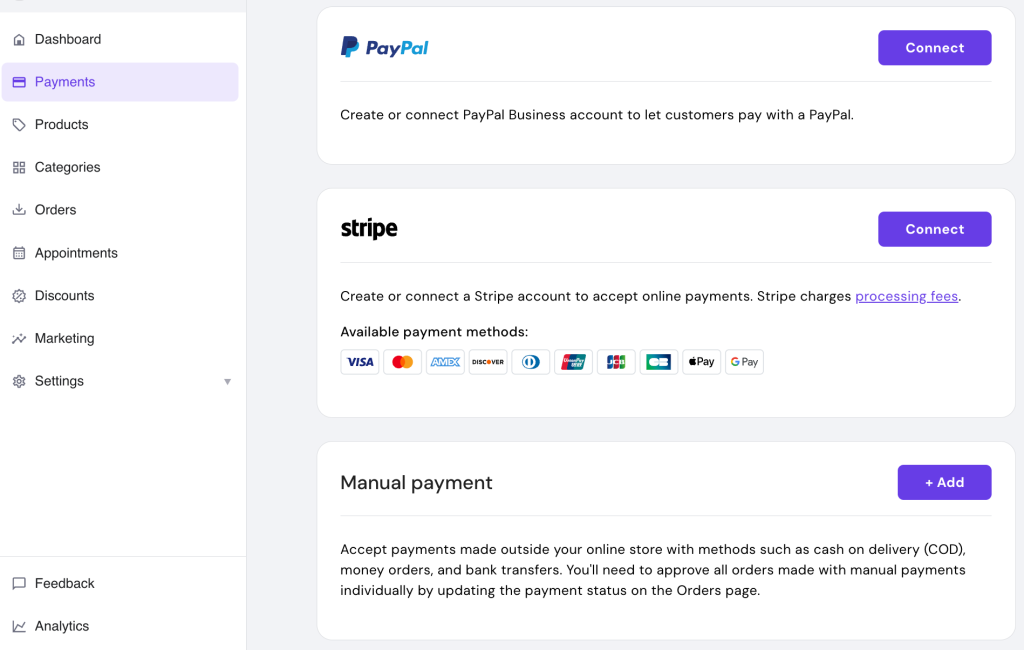
Shipping options
Paintings can be fragile, so you need to take extra precautions when shipping.
It’s best to ship larger works in cardboard mailing tubes and smaller paintings in rigid cardboard envelopes.
Within the packaging, use cellophane sleeves or protective paper to ensure your art doesn’t get damaged.
To impress the buyer, feature your branding on the packaging and include a personalized note. It’s these little details that delight buyers and create a memorable experience with your brand.
Imagine how someone feels when they receive a beautifully packaged gift from a dear friend compared to when they receive another regular package from a random online retailer. You want buyers to feel that difference when they receive your art so they will tell others about it and become loyal customers.
7. Promote your paintings online
There are so many ways to promote your artwork. The key is to choose a few strategies that you enjoy or that you know you can stick with. Focus on those first and then later, if you want, you can experiment with other strategies.
Here are some of the most effective promotional methods.
SEO for art websites
Search Engine Optimization (SEO) is the process of trying to get your website to rank high on search engines like Google for certain keywords.
If you paint beach landscapes, you might try to rank for keywords like “beach landscape painting”. You do this by including that specific keyword on your website throughout the titles and content.
Find relevant keywords using Google Keyword Planner, and be sure to stick to keywords that are highly relevant to your artwork.
Your homepage, product pages, and gallery pages are good places to include these targeted keywords.
Blogging
Consider starting a blog to rank for more keywords.
For the “beach landscape paintings” keyword, you could write a post about what inspires your paintings and how you create this artwork. Then showcase some of your best beach landscape paintings.
Do the same for various types of artwork you create. The goal is to write SEO-friendly content so each post appears in search results for different keywords that people search for.
Social media
Instagram, Facebook, TikTok, and Pinterest are all great places to get your paintings in front of art lovers. The challenge is that each platform works better with different types of content.
For example, Pinterest works great for images and posting SEO-friendly descriptions.
Facebook works well when you create a page for your brand and interact with other groups related to your art style.
TikTok and Instagram are image and video-focused, so you have to upload the correct type of content and identify the right hashtags to find the right audience. Hashtags related to your artwork, such as #beachlandscapepainting or #petportraits, could work well.
A good way to decide which social media platforms might be effective for you is to explore accounts similar to your style, and see where you can add value or provide something unique.
Building your brand
As an artist, your brand is what will bring more value to your paintings. People buy paintings but they also buy into the brand of the artist.
Building your brand starts with sharing your story and includes what inspires you and your unique perspective.
Vonderhaart does this beautifully by sharing JoAnne’s artistic journey and even taking people into her studio.

Build on this by sharing behind-the-scenes content. A simple way to do this is to use your phone to record your canvas while painting.
Gabrielle Carre Artist does this well on Instagram, where they take followers on the journey of creating their paintings, from sketching out the concept to applying the finishing touches.

Don’t be afraid to put yourself out there. People want to connect with you through your art, so be sure to share your story throughout your marketing efforts.
8. Provide outstanding customer service
Respond quickly to questions, handle feedback appropriately, and manage sales effectively to make a great impression on customers.
The first step is to make it as easy as possible for people to contact you. This can be done by having a contact form on your website and encouraging people to reach out as Lolo and Co Art does.
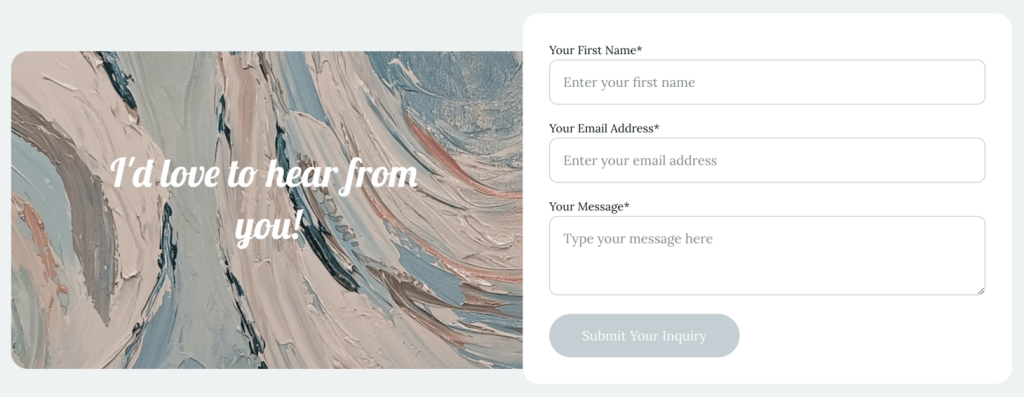
Consider setting up notifications so you don’t miss any messages and can respond within an appropriate timeframe, such as 24 hours.
From time to time, you might receive feedback about your art or the sales process. Sometimes this will be positive feedback. Other times it might not be. In these cases, be respectful and understanding. Don’t simply take it as criticism but use it as information to improve.
Once you start making sales, keep customers updated by emailing them expected processing times, shipping details, and any other details the customer might appreciate.
Make your brand all about positive experiences, from seeing your content on social media to placing an order on your website and then finally receiving the artwork.
Conclusion
There’s a lot to think about when you’re trying to sell paintings online, but it’s exciting to take your passion to the next level.
Let’s recap the steps we covered:
- Decide if you will sell originals, prints, commissions, or a combination of all of these
- Create your website to showcase your work in the best possible way
- Setup profiles on online marketplaces to reach a wider audience
- Price paintings competitively, taking into account your costs and the value you provide
- Take high-quality photos or scans of your paintings
- Setup various options to receive payments and ship paintings securely
- Promote your paintings and build your personal brand
- Provide exceptional service to gain a loyal customer base
There are so many ways to get your work out there and start earning money. Following these steps can be the beginning of a rewarding journey. Keep learning, keep creating amazing art, and build your brand.
How to sell paintings online FAQ
What are effective marketing strategies for selling art?
To sell art effectively, you should create a professional online presence with your own website and maintain active social media profiles. Share your story to build your personal brand and create a loyal customer base around your artwork.
Is selling art online profitable?
Selling art online can be profitable, but success depends on factors like your art style, your marketing efforts, pricing strategy, and target audience. It also requires persistence and making informed business decisions alongside your artistic talent.
Are there any fees associated with selling art online?
Selling art online usually involves different fees, including platform commissions, payment processing charges, shipping costs, website hosting expenses, and marketing costs. These fees will vary depending on the platforms and services you use.




